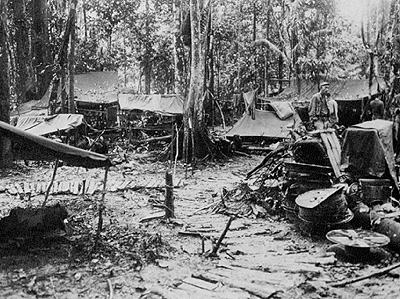
American resistance and Japanese supply difficulties made Adachi forsake his original plan to destroy the U.S. covering force and then to regroup for a main attack against the Allied defenses near Aitape. He now threw his reserves and available support troops into the battle raging along the Driniumor. Ordering a "temporary suspension" of preparations for an attack against the main American positions, Adachi directed "all available" force be used to strengthen the frontline units engaged with the Americans.
Area of the 112th Cavalry command post, showing rugged conditions at Aitape.
Bolstered by these reinforcements, the 41st and 20th divisions would continue their attacks against the estimated five U.S. battalions on or near the Driniumor. The 79th Infantry Regiment would advance simultaneously against Afua from the southeast. A fragmented version of this signal was later available to SWPA via Ultra. [62]
Not privy to the gleanings from Ultra until several days afterward, General Hall at Persecution Task Force Headquarters still did not comprehend that the entire 20th Division was moving on Afua. Hall was, however, thoroughly dissatisfied with General Gill's seeming lack of progress, and he made his feeling explicit in the following message to Gill.
[63] .
FOR EYES OF GENERAL GILL
CAREFUL ANALYSIS OF YOUR SITUATION DISCLOSES AT YOUR DISPOSAL 127, 128
(-), 124(-), 112th, SOME TD'S AND ENGINEERS. CONFRONTING YOU WEST OF DRINIUMOR IS AN UNDETERMINED NUMBER OF JAPS BUT CERTAINLY NOT YOUR EQUAL IN EITHER NUMBER OR FIRE POWER. IT APPEARS TO ME THAT WITH THE FORCES AT YOUR DISPOSAL IF THE PROPER OFFENSIVE ACTION IS INSTITUTED AT ONCE YOU SHOULD BE ABLE TO CLEAR THE AREA WEST OF THE DRINIUMOR WITHIN 48 HOURS. TROOP MOVEMENTS HAVE BEEN DELAYED AND I CANNOT PROMISE YOU ANY REINFORCEMENT. I DO NOT ATTEMPT TO TELL YOU WHAT MEASURES TO TAKE TO COUNTER AN OFFENSIVE FROM THE EAST AND AT THE SAME TIME CLEAN UP THE SITUATION WEST OF THE DRINIUMOR. IT CANNOT BE DONE BY DEFENSIVE ACTION. I EXPECT YOU TO TAKE ALL OFFENSIVE MEASURES NOT ONLY TO CLARIFY THE SITUATION BUT TO ERADICATE THE ENEMY WEST OF THE DRINIUMOR. YOU MUST DO IT WITH YOUR OWN FORCES WHICH ARE CONSIDERED ADEQUATE FOR THE PURPOSE. WE CANNOT WASTE TIME BY DILATORY TACTICS. WHILE I CAN APPRECIATE THAT SOME OF YOUR TROOPS ARE TIRED I KNOW OF NO BATTLE WHICH WAS ENTERED INTO WITH FRESH TROOPS. PLEASE GIVE THIS YOUR PERSONAL ATTENTION AND PUSH IT TO A CONCLUSION IN ORDER THAT INCOMING TROOPS MAY BE USED TO FINISH UP THIS SITUATION OUTSIDE OF YOUR AREA. Hall's directive must be understood in a strategic rather than a tactical context. In late spring 1944, Washington planners reconsidered the idea of bypassing the Philippines in favor of an attack against Formosa. The Combined Chiefs conference in London in early June endorsed the Formosa plan, and a JCS notification to MacArthur
on 12 June stated that in order to expedite the Pacific Campaign, "presently selected objectives" (read Philippines) would be bypassed in favor of an invasion of Formosa.
MacArthur attempted to rebut the JCS note in an 18 June message, but by this time General George C. Marshall also was leaning toward the Formosa plan.
Nevertheless, MacArthur had his plan to retake the Philippines ready by 10 July, and this was the strategy he tried "to sell" to President Franklin D. Roosevelt when they met in Hawaii from 26 to 29 July. In this light, it seems logical that MacArthur was pressuring his subordinates to conclude the Aitape campaign rapidly in order to demonstrate the efficacy of his strategic concepts and thereby win presidential endorsement for his Philippine plan. Strategic decision making directly influenced the tactical conduct of the Aitape fighting and, in large measure, accounts for the enormous pressure from above that General Gill described. Tactics, however, did not exert a reciprocal influence on strategy, because Gill could not finish the campaign in forty-eight
hours. Nor did the Hawaii meeting clarify U.S. Pacific strategy to the degree MacArthur desired. [64]
The immediate impact on the 112th was that Gill rejected General
Cunningham's plea for an additional rifle battalion. Higher headquarters' apparently
cavalier disapproval infuriated Cunningham, who compensated by shortening his line, bending his south flank back from the Driniumor along the Afua-Palauru trail, and stationing Troop A on the high ground guarding the western extremity of his new position. [65]
He was convinced that a numerically superior enemy force was outflanking the regiment from the south. He also had unsettling reports of Japanese troops to his west and northwest, where a Japanese roadblock prevented overland resupply at River X, and was uncertain about his routes of withdrawal, should the necessity arise. For all Cunningham knew, the 112th Cavalry might already be surrounded. The men could only dig deeper, improve their defensive positions, and distribute ammunition dropped by
plane. Their fate had become intertwined with that of the Japanese soldiers in Miyake Force, who spent 17 July slowly maneuvering into their assembly areas north and northwest of Afua for the attack on the 112th Cavalry.
Chapter 7: Attrition
16 July 44 0005
TO: GILL, CG, PCF
--HALL
Chapter 7: Directives
Chapter 7: Miyake Force
Chapter 7: Regrouping
Chapter 7: Rescue of Troop C
Chapter 7: US Redeployment
Chapter 7: Japanese Flank Attack
Chapter 7: Japanese Change of Plan
Chapter 7: Aftermath
Back to Table of Contents -- Leavenworth Papers # 9
Back to Leavenworth Papers List of Issues
Back to MagWeb Master Magazine List
© Copyright 2005 by Coalition Web, Inc.
This article appears in MagWeb.com (Magazine Web) on the Internet World Wide Web. Other articles from military history and related magazines are available at http://www.magweb.com